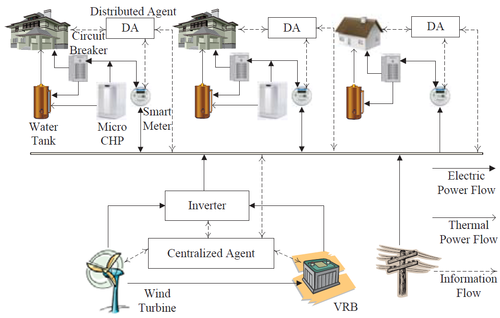Smart Grid and Microgrid
From NUEESS
Contents |
Description
Background
Sustainability has become an imperative requirement on many infrastructures and systems of our society with the impending energy crisis and environment deterioration.Power grids are being transformed into Smart Grid with advanced sensors, information and communication technologies.In smart grid, the energy flow will become two-way between the grid and consumers with renewable energy generations, which will be monitored and controlled by sensors, smart meters, digital controls and analytical tools. Smart Grid usually introduces Demand Response (DR) and Distributed Generation (DG) to improve energy consumption and generation efficiency.
Purpose
- Community level Microgrid based system scheme is designed to make the sustainable energy usage more affordable for ordinary residents.
- Dynamic residential DR with enhanced user-agent interaction is designed for user's preference adaption.
- Shared Cost-led Micro Combined Heat and Power (CHP) management strategy is designed to increase the DG utilization and reduce energy consumption cost.
- Vanadium Redox Battery (VRB) is management for environment adaptive discharging.
System Scheme
The Microgrid is invested and shared by a cluster of residents. According to ratios of investment, residents subscribe certain amount of power from the microgrid with low price for unpaid investment cost, fuel cost and management cost. There are three types of flow in the microgrid: electric power flow, thermal power flow and information flow. The electric power is powered by both utility grid and internal hybrid energy generated by wind turbine, micro CHP systems, and battery discharging. Micro CHP is a smaller size CHP for residential generation. For general consideration, some houses in the community are equipped with micro CHP systems, whereas others are not. For the latter, thermal energy can only be generated by electric heat pump. The thermal energy will be stored in the form of hot water in the tank and can be consumed in the future. VRB is chosen to store surplus wind energy and discharge when the wind energy is insufficient for the demand to reduce the energy consumption cost.
The management of the microgrid is based on hierarchical optimization and bill balance. The hierachical optimization is based on centralized and distributed agents and has 3 steps.
- Dynamic residential DR for energy consumption cost reduction, high user's convenience rate and user's preference adaption.
- Shared cost-led micro CHP generation management for cost reduction.
- Environment adaptive VRB discharging management for cost reduction considering stochastic elements.
System Models
Dynamic Residential DR
Electricity demands are represented as schedulable and fixed energy consumption tasks. Dynamic DR focuses on the schedulable load. Schedulable tasks have their own convenience rate distributions, which reflect the satisfaction users can get when tasks are executed at different time. The model of dynamic DR consists of dynamic task array, external information and task convenience rate function as inputs, and generate task scheduling as outputs. After scheduling, only tasks scheduled in current decision period are executed. Others will be rescheduled in the next decision period with updated external information. DR agent will optimize the following cost function considering both energy consumption cost and user's convenience:
People
Publications
| Whos here now: Members 0 Guests 0 Bots & Crawlers 2 |


